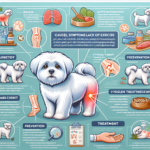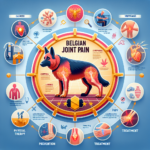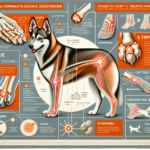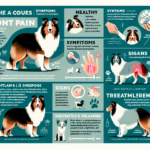Maltese Joint Pain: Causes, Symptoms, Prevention, and Treatment

Introduction
The Maltese is a small, charming breed known for its long, silky white coat and affectionate nature. Originating from the Mediterranean island of Malta, this breed has a rich history dating back over 2,000 years. The Maltese has been a beloved companion to royalty and aristocrats throughout history, and today, it continues to be a popular choice for families and individuals seeking a loyal and loving pet.
Despite their generally robust health, Maltese dogs are prone to certain health issues, including dental problems, respiratory issues, and joint pain. Joint health is particularly crucial for the Maltese due to their small size and delicate bone structure. Ensuring that their joints remain healthy can significantly impact their quality of life and longevity.
Breed-Specific Joint Pain Risks
Genetic Predisposition
The Maltese breed is genetically predisposed to several joint-related issues, including hip dysplasia, patellar luxation, and arthritis. Hip dysplasia, although more common in larger breeds, can still affect small breeds like the Maltese. Patellar luxation, where the kneecap dislocates or moves out of its normal position, is particularly prevalent in small breeds and can lead to significant discomfort and mobility issues.
Age-Related Risks
As Maltese dogs age, the risk of developing joint pain increases. Degenerative joint diseases such as osteoarthritis are common in older dogs and can lead to chronic pain and reduced mobility. Owners should be vigilant about monitoring their Maltese for signs of joint pain as they reach middle age, typically around 7-8 years old.
Activity Level and Joint Stress
The Maltese is an active and playful breed, often engaging in activities that can put stress on their joints. While regular exercise is essential for maintaining overall health, excessive jumping or running on hard surfaces can exacerbate joint issues. Owners should balance their Maltese’s activity level to prevent undue stress on their joints.
Common Symptoms of Joint Pain in Maltese
General Symptoms
- Limping or favoring one leg
- Stiffness, especially after rest
- Reluctance to jump or climb stairs
- Decreased activity or playfulness
- Whining or yelping when touched
- Visible swelling around the joints
Breed-Specific Symptoms
In Maltese dogs, joint pain may manifest more subtly due to their small size. Owners might notice a reluctance to be picked up or a change in their gait. Additionally, Maltese dogs may become more irritable or less social if they are experiencing chronic pain.
When to Consult a Vet
If your Maltese exhibits any of the above symptoms for more than a few days, it is essential to consult a veterinarian. Early diagnosis and treatment can prevent further deterioration and improve your dog’s quality of life. Regular veterinary check-ups are also crucial for early detection of joint issues.
Preventive Measures for Joint Health
Exercise Recommendations
Regular, moderate exercise is vital for maintaining joint health in Maltese dogs. Short walks, gentle play sessions, and low-impact activities like swimming can help keep their joints flexible and muscles strong. Avoid high-impact activities such as jumping from heights or running on hard surfaces.
Dietary Suggestions
A balanced diet rich in essential nutrients can support joint health. Look for dog foods that contain glucosamine and chondroitin, which help maintain cartilage health. Omega-3 fatty acids, found in fish oil supplements, can also reduce inflammation and support joint function. Always consult your veterinarian before adding supplements to your dog’s diet.
Weight Management
Maintaining a healthy weight is crucial for reducing joint stress in Maltese dogs. Obesity can exacerbate joint issues and lead to other health problems. Monitor your dog’s weight and adjust their diet and exercise routine as needed to keep them at an optimal weight.
Early Screening and Monitoring
Regular veterinary check-ups and early screening for joint issues can help catch problems before they become severe. Your veterinarian may recommend X-rays or other diagnostic tests to assess your dog’s joint health. Early intervention can significantly improve outcomes for dogs with joint issues.
Treatment Options for Joint Pain
Non-Surgical Treatments
Non-surgical treatments for joint pain in Maltese dogs include medications, physical therapy, and lifestyle adjustments. Anti-inflammatory medications and pain relievers can help manage symptoms, while physical therapy can improve mobility and strengthen muscles. Lifestyle adjustments, such as providing a comfortable bed and avoiding high-impact activities, can also alleviate joint pain.
Surgical Options
In severe cases, surgical intervention may be necessary to address joint pain. Common surgeries for joint issues in Maltese dogs include patellar luxation repair, hip replacement, and arthroscopy. These procedures can significantly improve your dog’s quality of life, but they come with risks and require a thorough discussion with your veterinarian.
Alternative Therapies
Alternative therapies such as acupuncture, hydrotherapy, and massage can also benefit Maltese dogs with joint pain. Acupuncture can help reduce pain and inflammation, while hydrotherapy provides low-impact exercise that supports joint health. Massage can improve circulation and reduce muscle tension around the joints.
Lifestyle and Management Tips
Daily Care Routine
A consistent daily care routine can help manage and alleviate joint pain in Maltese dogs. This routine might include gentle exercise, administering medications or supplements, and providing a comfortable resting area. Regular grooming can also help you monitor your dog’s overall health and detect any changes in their condition.
Modifying the Home Environment
Making your home more comfortable for a dog with joint pain can significantly improve their quality of life. Consider adding ramps to help them navigate stairs, providing orthopedic beds for better support, and placing non-slip mats on slippery surfaces. These modifications can reduce the risk of injury and make daily activities easier for your dog.
Long-Term Management
Long-term management of joint pain involves regular veterinary check-ups, ongoing monitoring of your dog’s condition, and adjusting their care routine as needed. Keeping your Maltese active and engaged with low-impact activities can help maintain their mobility and overall well-being. Consistent weight management and a balanced diet are also crucial for long-term joint health.
FAQs About Maltese and Joint Pain
What are the early signs of joint pain in Maltese dogs?
Early signs of joint pain in Maltese dogs include limping, stiffness, reluctance to jump or climb stairs, and decreased activity levels. If you notice any of these symptoms, consult your veterinarian for a thorough evaluation.
Can joint pain in Maltese dogs be prevented?
While genetic predispositions cannot be entirely prevented, you can take steps to reduce the risk of joint pain in your Maltese. Regular exercise, a balanced diet, weight management, and early screening can all contribute to maintaining joint health.
Are there specific exercises that are better for Maltese dogs with joint pain?
Low-impact exercises such as short walks, gentle play sessions, and swimming are ideal for Maltese dogs with joint pain. Avoid high-impact activities like jumping or running on hard surfaces, as these can exacerbate joint issues.
What dietary supplements can help with joint health in Maltese dogs?
Supplements containing glucosamine, chondroitin, and omega-3 fatty acids can support joint health in Maltese dogs. Always consult your veterinarian before adding any supplements to your dog’s diet to ensure they are appropriate and safe.
When should I consider surgery for my Maltese’s joint pain?
Surgery should be considered when non-surgical treatments are no longer effective, and your dog’s quality of life is significantly impacted by joint pain. Discuss the potential benefits and risks of surgical options with your veterinarian to make an informed decision.
Conclusion
Joint pain is a common concern for Maltese dogs, but with proper care and attention, it can be managed effectively. By understanding the breed-specific risks, recognizing early symptoms, and implementing preventive measures, you can help ensure your Maltese remains healthy and active. Regular veterinary check-ups and a balanced approach to exercise, diet, and weight management are crucial for maintaining joint health. If joint pain does develop, a range of treatment options, including non-surgical and surgical interventions, can provide relief and improve your dog’s quality of life. Always consult your veterinarian for personalized advice and care tailored to your Maltese’s needs.




